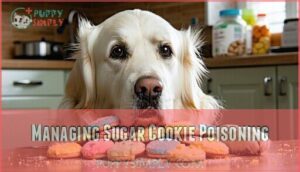This site is supported by our readers. We may earn a commission, at no cost to you, if you purchase through links.

These sweet treats contain high amounts of sugar, butter, and potentially toxic elements like chocolate chips, raisins, or xylitol that can cause everything from stomach upset to life-threatening poisoning.
The excessive sugar and fat can trigger pancreatitis, while artificial sweeteners like xylitol can cause dangerous drops in blood sugar.
Even plain sugar cookies contribute to obesity and dental problems.
Instead of risking your pup’s health, stick to dog-safe alternatives made with ingredients like peanut butter or pumpkin that’ll satisfy their cravings without the scary consequences.
Table Of Contents
- Key Takeaways
- Sugar Cookies and Dogs
- Can Dogs Eat Sugar Cookies
- Health Risks of Sugar Cookies
- Safe Alternatives to Sugar Cookies
- Symptoms of Sugar Cookie Ingestion
- What to Do if Dog Eats Sugar Cookie
- Preventing Sugar Cookie Ingestion
- Dog-Friendly Cookie Recipes
- Managing Sugar Cookie Poisoning
- Keeping Dogs Safe From Sugar Cookies
- Frequently Asked Questions (FAQs)
- Are cookies safe for dogs?
- Are sugar cookies bad for dogs?
- Can dogs eat sugar cookies with icing?
- Can dogs eat human cookies?
- Can dogs eat wheat cookies?
- Can dogs eat chocolate cookies?
- What will happen if my dog eats a sugar cookie?
- What happens if a dog eats a little bit of sugar?
- Is a little sugar ok for dogs?
- Can I give my dog sugar snaps?
- Conclusion
Key Takeaways
- You shouldn’t give your dog sugar cookies because they contain harmful ingredients like high sugar, butter, and potentially toxic substances such as chocolate, xylitol, or raisins that can cause stomach upset, pancreatitis, or life-threatening poisoning.
- You’ll need to watch for warning signs if your dog accidentally eats sugar cookies, including vomiting, diarrhea, lethargy, increased thirst, and abdominal pain that can appear within hours of ingestion.
- You can make safe alternatives using dog-friendly ingredients like peanut butter (xylitol-free), pumpkin, oats, and carob chips that’ll satisfy your dog’s cravings without the health risks.
- You should contact your veterinarian immediately if your dog consumes sugar cookies, especially those containing chocolate, xylitol, or raisins, and never attempt to induce vomiting without professional guidance.
Sugar Cookies and Dogs
When you see your dog’s hopeful eyes watching you enjoy sugar cookies, you might wonder if sharing one small treat could hurt.
The truth is that sugar cookies contain several ingredients that can make your furry friend seriously ill, from the high sugar and fat content to potentially toxic additions like chocolate, raisins, or xylitol.
**Sharing sugar cookies with your dog isn’t sweet—it’s a recipe for an emergency vet visit.
Toxic Ingredients in Cookies
Beyond the obvious sugar content, cookies harbor several toxic ingredients that can turn your dog’s treat into a trip to the emergency vet.
These common cookie components pose serious health risks:
- Chocolate toxicity – Even small amounts can cause seizures and heart problems
- Xylitol risks – This artificial sweetener triggers dangerous blood sugar drops
- Raisin dangers – Can cause sudden kidney failure
- Nutmeg poisoning – Leads to hallucinations and tremors
Harmful Effects of Sugar on Dogs
Regular sugar consumption creates a cascade of health problems for your dog.
Sugar’s impact on organ function affects the liver, pancreas, and kidneys, while obesity risks increase dramatically with sweet treats.
Dental problems develop quickly from sugar exposure, and diabetes onset becomes a serious concern.
Understanding sugar effects on dogs helps prevent cookie poisoning and protects against sugar toxicity in dogs.
Common Symptoms of Cookie Ingestion
When your dog sneaks sugar cookies, watch for telltale signs of cookie poisoning dogs.
Vomiting and diarrhea often appear first, followed by lethargy and abdominal pain.
You might notice appetite loss as toxic ingredients cookies wreak havoc on their system.
These symptoms can develop within hours after dogs eat cookies, so stay alert for any changes in behavior or comfort levels, and be aware of telltale signs.
Can Dogs Eat Sugar Cookies
The simple answer is no – dogs shouldn’t eat sugar cookies. While plain sugar cookies won’t immediately poison your furry friend like chocolate would, they’re definitely not safe for regular consumption.
Most cookie ingredients pose various health risks for dogs, from high sugar content that can spike blood glucose levels to butter that’s loaded with fat. When you’re wondering "are sugar cookies safe" for your pet, consider this: sugar effects dogs differently than humans.
Their digestive systems can’t handle the sugar toxicity that comes from sweet treats. Even small amounts can trigger ingestion symptoms like vomiting, diarrhea, and stomach upset.
Instead of sharing your holiday cookies, look into safe alternatives made specifically for dogs. If your dog accidentally gets into sugar cookies dogs shouldn’t have, monitor them closely and contact your vet if concerning symptoms appear. When in doubt, seek veterinary attention promptly.
Health Risks of Sugar Cookies
When your dog’s pleading eyes convince you to share that sugar cookie, you’re unknowingly exposing them to serious health complications that can range from stomach upset to life-threatening poisoning.
Sugar cookies contain multiple ingredients that can harm your pet, including high fat content that triggers pancreatitis, toxic substances like chocolate and xylitol, and excessive sugar that disrupts their digestive system.
Pancreatitis and High Fat Content
Sugar cookies pack a dangerous punch with their high fat content from butter and other rich ingredients.
This dietary fat overload can trigger pancreatitis in dogs, causing severe abdominal pain and potentially life-threatening complications.
Here are five key pancreatitis symptoms to watch for:
- Severe vomiting that won’t stop or comes in waves
- Hunched posture with obvious abdominal discomfort and pain
- Loss of appetite and complete refusal to eat
- Lethargy and unusual weakness or depression
- Fever accompanied by rapid, shallow breathing
Chocolate and Raisin Toxicity
Beyond pancreatitis concerns, chocolate and raisin toxicity pose life-threatening risks.
Chocolate’s theobromine affects your dog’s nervous system, while raisins cause kidney failure.
Even small amounts trigger severe reactions within hours.
| Toxic Ingredient | Dangerous Component |
|---|---|
| Dark Chocolate | High theobromine levels |
| Milk Chocolate | Moderate theobromine content |
| Raisins | Tartaric acid compounds |
| Chocolate Chips | Concentrated theobromine |
| Dried Grapes | Kidney-damaging toxins |
Immediate actions include contacting your veterinarian immediately.
Xylitol Poisoning in Dogs
Hidden within sugar-free cookies lurks xylitol, a deadly sweetener that’ll send your dog’s blood sugar plummeting within thirty minutes.
This artificial sugar substitute causes severe hypoglycemia, liver damage, and potentially death.
Even tiny amounts prove toxic—just 0.1 grams per kilogram triggers poisoning. Contact animal poison control immediately if your pup ingests xylitol-containing treats, as aggressive treatment determines survival.
Safe Alternatives to Sugar Cookies
You don’t have to deny your dog treats completely when sugar cookies are off-limits.
Instead, you can create homemade dog-friendly alternatives using safe ingredients like peanut butter, pumpkin, oats, and carob chips that’ll satisfy their sweet tooth without risking their health, by using safe ingredients.
Homemade Dog-Friendly Treats
Three simple ingredients can transform your kitchen into a dog-friendly bakery. Homemade dog cookies using safe ingredients like oats, bananas, and xylitol-free peanut butter offer complete nutritional balance.
These cookie ingredients dogs actually love require basic baking methods at 350°F. Consider chewy dog treats for a softer texture.
Store dogfriendly recipe treats in airtight containers, giving you safe cookie alternatives that beat store-bought options every time, with basic baking methods.
Peanut Butter and Pumpkin Recipes
Making homemade dog cookies becomes easier with peanut butter and pumpkin as your go-to ingredients.
Peanut butter safety means choosing xylitol-free brands, while pumpkin benefits include fiber and vitamins.
These recipe variations offer endless ingredient substitutions – swap wheat flour for oat flour.
Many owners also bake peanut butter dog treats for their furry friends.
Essential baking tips: keep temperatures low and avoid adding sugar to your dogfriendly recipe creations, using low temperatures.
Carob Chip and Oatmeal Cookies
Everyone’s searching for healthy dog snacks that won’t harm their furry friends.
Carob benefits include being chocolate-safe, while oatmeal nutrition provides fiber and energy. These safe ingredients make perfect dog treats cookies.
Try recipe variations using plain oats and unsweetened carob chips. As carob chips for dogs become more popular, many owners are seeking ways to incorporate them.
Follow baking tips like avoiding sugar effects dogs experience. Your dog health cookies become guilt-free indulgences both you and your pup can enjoy together.
Symptoms of Sugar Cookie Ingestion
When your dog sneaks a sugar cookie, you’ll want to watch for several warning signs that indicate their system is struggling with the sweet treat.
The most common symptoms include vomiting, diarrhea, lethargy, increased thirst, and abdominal discomfort, which can appear within hours of ingestion and signal your pet needs immediate attention.
Vomiting and Diarrhea in Dogs
Your dog’s stomach will rebel after eating sugar cookies, causing messy digestive chaos.
Sugar toxicity in dogs experience happens through gastrointestinal upset that manifests quickly.
Watch for these warning signs:
- Projectile vomiting within hours
- Watery diarrhea episodes
- Stomach cramping and discomfort
- Dehydration from fluid loss
Causes include high sugar content overwhelming their system, leading to symptom management as the primary treatment approach.
Treatments focus on managing symptoms, and prevention means keeping cookies away.
Monitoring prevents complications.
Lethargy and Increased Thirst
Beyond stomach troubles, your dog might seem unusually tired and drink more water than usual.
Lethargy signals energy depletion from sugar toxicity dogs experience when processing sugar cookies.
Increased thirst indicates underlying causes affecting kidney function and natural thirst mechanisms, which can lead to dehydration risks that compound quickly.
These risks make your normally playful pup appear sluggish and constantly seeking their water bowl, due to sugar toxicity.
Abdominal Pain and Loss of Appetite
Your dog’s digestive system takes a real beating when processing sugar cookies.
Abdominal pain often shows up as hunched posture, whimpering, or reluctance to move.
Loss of appetite typically follows as their stomach rebels against the sugar overload.
These symptoms signal sugar toxicity, requiring immediate monitoring.
Prevention through proper dog dietary needs and understanding their sensitive digestive systems helps avoid treatment complications.
What to Do if Dog Eats Sugar Cookie
If your dog has snatched a sugar cookie when you weren’t looking, don’t panic but act quickly to assess the situation.
Contact your veterinarian immediately for guidance, especially if the cookie contained chocolate, xylitol, or raisins, as these ingredients can cause serious health complications in dogs.
Inducing Vomiting and Activated Charcoal
Don’t attempt inducing vomiting at home—vomiting safety requires professional veterinary consultation.
Your vet will determine if it’s appropriate within two hours of ingestion and handle the procedure safely. Activated charcoal may follow to prevent further toxin absorption, but charcoal effectiveness depends on timing and toxic ingredients involved.
Only veterinary care guarantees proper post-treatment care after poisoning incidents.
Monitoring Behavior and Symptoms
Close observation becomes your lifeline after dogs consume sugar cookies.
Watch for pet symptoms like vomiting, diarrhea, or lethargy within your Symptom Timeline of 24-48 hours.
Monitor Behavioral Changes, Appetite Monitoring, and Hydration Levels carefully.
Document everything for smooth Vet Communication.
Your vigilant pet monitoring helps catch problems early, ensuring proper veterinary care when needed.
Seeking Veterinary Attention
When in doubt about pet symptoms, don’t hesitate to seek veterinary attention immediately.
Emergency signs like persistent vomiting, difficulty breathing, or seizures require urgent veterinary care.
Your vet will handle toxin identification and recommend appropriate treatment options.
They’ll also guide you through post-treatment care and discuss preventative measures.
Pet monitoring becomes easier with professional guidance—seeking help early prevents complications.
Preventing Sugar Cookie Ingestion
You can keep your dog safe from sugar cookies by storing them in secure containers or on high shelves where curious paws can’t reach them.
Teaching everyone in your household about which human foods are dangerous for dogs, and keeping a close eye on your pet during baking sessions, helps prevent accidental ingestion before it happens, which is a preventive measure.
Storing Cookies Out of Reach
Smart pet owners know that preventing access beats treating problems later.
Keep sugar cookies away from curious paws with these essential petproofing strategies:
- Secure containers with tight-fitting lids prevent sneaky raids
- Elevated storage on high shelves keeps treats unreachable
- Childproofing methods like cabinet locks work for pets too
- Pet-proof pantries eliminate temptation entirely
These preventative measures protect dogs from toxic ingredients while maintaining pet safety.
Educating Household Members
Everyone in your home needs to know which foods can harm your dog.
Share a Toxic Food List that includes sugar cookies and their toxic ingredients with all family members and guests.
When everyone understands the risks, Family Involvement in Secure Food Storage becomes second nature, protecting your dog’s health through consistent messaging about keeping human treats away from pets, making Pet Safety Education a family priority.
Regularly Monitoring Pets
Keeping a watchful eye on your dog’s daily habits helps catch problems before they spiral out of control.
Early detection through home monitoring can save your pet’s life when sugar cookies or other harmful treats slip past your defenses.
- Notice sudden changes in eating patterns or energy levels
- Watch for unusual bathroom habits or drinking behaviors
- Document symptoms to share during veterinary communication
Behavioral changes often signal trouble brewing. Your dog can’t tell you they’re feeling sick, so symptom recognition becomes your responsibility. Regular observation transforms you into your pet’s first line of defense against sugar cookie dangers and other dog health threats, which is crucial for early detection and can help prevent problems from getting out of control, emphasizing the importance of being aware of sudden changes and unusual behaviors to ensure your pet’s well-being and safety, ultimately relying on home monitoring.
Dog-Friendly Cookie Recipes
You can satisfy your dog’s sweet tooth safely by making homemade treats using dog-friendly ingredients like peanut butter, pumpkin, and oatmeal instead of harmful sugar cookie components.
These simple recipes let you control every ingredient, ensuring your furry friend gets a tasty reward without the risks of chocolate, xylitol, or excessive sugar that make regular cookies dangerous for dogs.
Easy Homemade Dog Treats
Three simple homemade treats can replace those dangerous sugar cookies your dog’s eyeing.
Start with peanut butter oat balls—mix rolled oats, natural peanut butter, and a banana.
These dog treats require no baking and store well in your fridge.
Creative recipes using healthy ingredients satisfy your pup’s sweet tooth while supporting proper dog nutrition and dietary needs.
Dog-Safe Ingredients and Substitutions
Your pantry holds treasure troves of safe cookie ingredients that’ll make your pup’s tail wag without worry.
Smart swaps transform dangerous recipes into nutritious dog-friendly treats that support overall dog nutrition.
Essential healthy treat swaps include:
- Replace sugar with natural sweeteners like applesauce or mashed banana
- Swap chocolate chips for dog-safe carob chips or blueberries
- Use whole wheat flour instead of refined white flour for added nutritional benefits
Baking Cookies for Dogs
When baking homemade cookies for your furry friend, ingredient substitutions make all the difference.
Replace sugar with safe sweeteners like honey or applesauce in small amounts. Recipe customization lets you meet your dog’s dietary needs perfectly.
Basic baking techniques remain the same, but skip chocolate chips for carob. These dog-friendly recipes create tail-wagging treats safely.
Managing Sugar Cookie Poisoning
If your dog has eaten sugar cookies, you’ll need to act quickly and monitor them closely for the next 24 to 48 hours.
Managing sugar cookie poisoning involves immediate first aid steps, careful observation of symptoms, and long-term dietary changes to prevent future incidents.
This approach ensures a comprehensive response to the situation, addressing both the immediate needs and the long-term health of your dog.
Immediate First Aid and Treatment
When your dog swallows sugar cookies, don’t panic but act quickly.
Never induce vomiting without veterinary guidance, as some ingredients can cause more harm coming back up. Call your vet immediately for professional advice.
Monitor symptoms like vomiting or diarrhea closely. Skip activated charcoal unless directed—it’s not effective for all cookie toxins.
Pet first aid starts with professional consultation.
Long-Term Management and Recovery
After your dog recovers from sugar cookie ingestion, you’ll need ongoing vigilance.
Monitor for persistent symptoms like vomiting or lethargy, and watch for diabetes signs including excessive thirst.
Dietary adjustments become essential—maintain low-sugar meals and avoid xylitol products completely.
Schedule regular vet check-ups to monitor blood sugar levels, and remember that exercise benefits overall health while preventative measures stop future incidents.
Dietary Adjustments and Avoiding Sugary Foods
After your dog recovers, you’ll need to make permanent dietary adjustments to prevent future issues.
Switch to a balanced diet with safe treats that follow canine dietary guidelines.
Read labels carefully to avoid sugar alternatives and hidden sweeteners.
Make gradual changes to your pet’s routine, exploring dietary alternatives that satisfy their cravings without compromising their health through excessive sugar consumption to ensure a healthy lifestyle with safe treats.
Keeping Dogs Safe From Sugar Cookies
You’ve learned about the risks sugar cookies pose to your dog, but preventing problems starts with smart prevention strategies.
The best approach combines storing treats securely, maintaining your dog’s regular diet, and scheduling routine vet visits to catch any health issues early, which is a key part of preventing problems.
Maintaining a Balanced Diet
After managing sugar cookie poisoning, you’ll want to focus on your dog’s overall wellness.
Meeting their nutritional needs through portion control helps maintain a healthy weight and prevents future incidents.
Quality dog food provides essential dietary fiber, while proper hydration importance can’t be overstated.
A balanced canine diet following veterinary dietary guidelines protects against dangerous sugar exposures, emphasizing the need for quality dog food.
Avoiding Sugary Snacks and Treats
Beyond maintaining proper nutrition, you’ll want to create barriers between your dog and tempting sweets.
Sugar cookies and similar treats pose real dog health risks that make vigilance worthwhile.
Here’s your action plan for sugar-free success:
- Replace pantry staples – Stock healthy dog treats instead of keeping sugar cookies within paw’s reach
- Master safe human foods – Learn which snacks you can share safely when moderation is key
- Practice reading food labels – Check ingredients before offering anything to maintain your balanced dog diet
Regular Veterinary Check-Ups and Consultations
Regular veterinary check-ups serve as your dog’s health insurance policy.
These visits aren’t just about vaccinations importance—they’re about preventative care that catches problems before they become expensive emergencies.
Your vet provides nutritional guidance, behavioral consults, and early detection of issues like diabetes from sugar overconsumption.
| Check-Up Type | Frequency | Benefits |
|---|---|---|
| Puppy Visits | Every 3-4 weeks | Vaccinations, growth monitoring |
| Adult Dogs | Annually | Preventative care, health screening |
| Senior Dogs (7+) | Every 6 months | Early detection, organ function |
| Emergency Visits | As needed | Professional guidance, immediate care |
Professional guidance helps you make informed decisions about your dog’s diet and treats, ensuring canine health stays on track.
Frequently Asked Questions (FAQs)
Are cookies safe for dogs?
Sure, your pup thinks they’re a connoisseur of human treats, but most cookies aren’t safe for dogs.
They contain sugar, butter, and potentially toxic ingredients like chocolate, xylitol, or raisins that can cause serious health issues, including problems related to chocolate.
Are sugar cookies bad for dogs?
Yes, sugar cookies are bad for dogs.
They’re loaded with sugar, butter, and potentially toxic ingredients like chocolate or xylitol.
You’ll risk stomach upset, pancreatitis, or worse.
Skip sharing your treats.
Can dogs eat sugar cookies with icing?
No, don’t give your dog sugar cookies with icing.
The frosting contains extra sugar and potentially toxic ingredients like xylitol.
Even plain sugar cookies can upset their stomach and cause diarrhea or vomiting.
Can dogs eat human cookies?
Most human cookies aren’t safe for your dog.
They’re loaded with sugar, butter, and potentially toxic ingredients like chocolate, raisins, or xylitol.
Skip sharing cookies and opt for dog-specific treats instead.
Can dogs eat wheat cookies?
Wheat cookies might seem harmless, but they’re not ideal for your dog.
While wheat itself isn’t toxic, cookies contain sugar, butter, and additives that can upset your pup’s stomach and contribute to obesity.
Can dogs eat chocolate cookies?
Chocolate cookies are absolutely off-limits for your dog.
Chocolate contains theobromine, which is toxic to dogs and can cause vomiting, diarrhea, rapid heart rate, seizures, and even death.
Keep them away completely.
What will happen if my dog eats a sugar cookie?
Like a sugar rush gone wrong, your dog might experience an upset stomach, vomiting, or diarrhea.
While one plain sugar cookie won’t poison them, the high sugar and fat content can cause uncomfortable digestive issues.
What happens if a dog eats a little bit of sugar?
When your dog eats a little sugar, you’ll likely see mild stomach upset, gas, or loose stools.
While not toxic, sugar can cause digestive discomfort and contribute to long-term health issues.
Is a little sugar ok for dogs?
Small amounts of sugar won’t poison your dog, but it’s not recommended.
Sugar can cause stomach upset, gas, and bloating.
Over time, it leads to obesity, dental problems, and diabetes.
Skip sugary treats altogether.
Can I give my dog sugar snaps?
Looking for a healthy veggie treat for your pup?
You can absolutely give your dog sugar snap peas!
They’re safe, nutritious, and packed with vitamins.
Just remove the strings and serve them fresh or lightly steamed.
Conclusion
Like a fortress protecting its most precious treasure, you must guard your dog from sugar cookies and their hidden dangers.
The answer to "can dogs eat sugar cookies" is a definitive no—these treats contain toxic ingredients that can cause serious health problems.
Keep cookies stored safely away from curious paws, offer dog-friendly alternatives instead, and always consult your veterinarian if your pet accidentally consumes sugary treats.
Your vigilance today protects your furry friend’s health tomorrow.
- https://www.thekennelclub.org.uk/health-and-dog-care/health/health-and-care/a-z-of-health-and-care-issues/poisonous-food/?gclid=Cj0KCQjwnoqLBhD4ARIsAL5JedKADacZmANu4yPhOvdZx6aqI8jxfaszykT8rwxpjSZn4mQVBZ1AimwaAkXNEALw_wcB
- https://www.petpoisonhelpline.com/poisons/
- https://www.petmd.com/nutmeg-safe-dogs


















